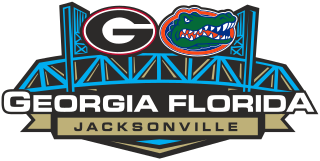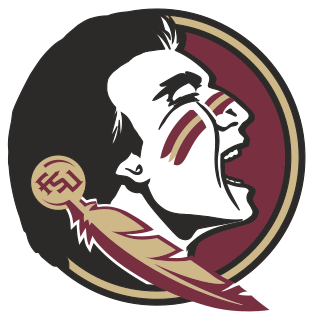
The University of Florida is a public land-grant research university in Gainesville, Florida. It is a senior member of the State University System of Florida, traces its origins to 1853, and has operated continuously on its Gainesville campus since September 1906.

The Florida–Georgia football rivalry is an American college football rivalry game played annually by the University of Florida Gators and the University of Georgia Bulldogs, both members of the Eastern Division of the Southeastern Conference. The programs first met in 1904 or 1915 and have played every season since 1926 except for a war-time interruption in 1943. It is one of the most prominent rivalry games in college football, and it has been held in Jacksonville, Florida since 1933, with only two exceptions, making it one of the few remaining neutral-site rivalries in college football. The game attracts huge crowds to Jacksonville, and the associated tailgating and other events earned it the nickname of the "World's Largest Outdoor Cocktail Party", although that name is no longer used officially.

The Florida Gators football program represents the University of Florida (UF) in American college football. Florida competes in the Football Bowl Subdivision (FBS) of the National Collegiate Athletic Association (NCAA) and the Eastern Division of the Southeastern Conference (SEC). They play their home games in Steve Spurrier-Florida Field at Ben Hill Griffin Stadium on the university's Gainesville campus.

The Florida State Seminoles football team represents Florida State University in the sport of American football. The Seminoles compete in the NCAA Division I Football Bowl Subdivision (FBS) of the National Collegiate Athletic Association (NCAA) and the Atlantic Division of the Atlantic Coast Conference (ACC). The team is known for its storied history, distinctive helmet, fight song, colors, and many other traditions associated with the school.
Reidel Clarence Anthony is a former American football wide receiver who played in the National Football League (NFL) from 1997 to 2001. Anthony played college football for the University of Florida, and received consensus All-American honors. He was a first-round pick in the 1997 NFL Draft, and played professionally for the Tampa Bay Buccaneers of the NFL.
Kerwin Douglas Bell is an American football coach and former player who is currently the Head Coach of the Western Carolina Catamounts football team. Bell was born in the North Central Florida town of Live Oak and was a star high school football quarterback at Lafayette County High School in nearby Mayo, Florida. Bell did not attract the attention of top college football programs while playing at the small high school, so he decided to attend the University of Florida in nearby Gainesville and joined the Gators as a walk-on.

The Florida–Florida State football rivalry is an American college football rivalry between the teams of the two oldest public universities of the U.S. state of Florida: the University of Florida Gators and Florida State University Seminoles. Both universities participate in a range of intercollegiate sports, and for the last several years, the Florida Department of Agriculture and Consumer Services has sponsored a "Sunshine Showdown" promotion that tallies the total number of wins for each school in head-to-head sports competition. However, the annual football game between the Gators and Seminoles has consistently been the most intense and notable competition between the in-state rivals.
Ricky Rennard Nattiel, nicknamed "Ricky the Rocket," is an American former college and professional football player who was a wide receiver in the National Football League (NFL) for six seasons during the 1980s and 1990s. Nattiel played college football for the University of Florida, and thereafter, he played professionally for the Denver Broncos of the NFL.
Tyrone Donnive Young was an American college and professional football player who was a wide receiver in the National Football League (NFL) for two seasons during the 1980s. Young played college football for the University of Florida, and thereafter, he played professionally for the NFL's New Orleans Saints.
Scot Eugene Brantley is an American radio and television sports broadcaster and former college and professional football player who was a linebacker in the National Football League (NFL) for eight seasons during the 1980s. Brantley played college football for the University of Florida, and thereafter, he played professionally for the Tampa Bay Buccaneers of the NFL.
Christopher Paul Doering is an American former college and professional football player who was a wide receiver in the National Football League (NFL) for seven seasons during the 1990s and 2000s. Doering played college football for the University of Florida, and thereafter, he played professionally for the Indianapolis Colts, the Denver Broncos, the Washington Redskins, and the Pittsburgh Steelers of the NFL.

The history of Florida State University dates to the 19th century and is deeply intertwined with the history of education in the state of Florida and in the city of Tallahassee. Florida State University, known colloquially as Florida State and FSU, is one of the oldest and largest of the institutions in the State University System of Florida. It traces its origins to the West Florida Seminary, one of two state-funded seminaries the Florida Legislature voted to establish in 1851.

The 1996 Florida Gators football team represented the University of Florida in the sport of American football during the 1996 NCAA Division I-A football season. The 1996 season was the team's seventh under head coach Steve Spurrier. The Gators competed in the Southeastern Conference (SEC) and played their home games at Ben Hill Griffin Stadium on the university's Gainesville, Florida campus.

James Adger "Jack" Forsythe Jr., nicknamed "Pee Wee" Forsythe, was an American college football player and coach. Forsythe has an important place in the history of college athletics in the U.S. state of Florida as the first head coach of the team now known as the University of Florida Gators. He had previously been the last football coach at Florida State College, now Florida State University, before it was reorganized as a school for women.

The history of the University of Florida is firmly tied to the history of public education in the state of Florida. The University of Florida originated as several distinct institutions that were consolidated to create a single state-supported university by the Buckman Act of 1905. The oldest of these was the East Florida Seminary, one of two seminaries of higher learning established by the Florida Legislature. The East Florida Seminary opened in Ocala 1853, becoming the first state-supported institution of higher learning in the state of Florida. As it is the oldest of the modern University of Florida's predecessor institutions, the school traces its founding date to that year. The East Florida Seminary closed its Ocala campus at the outbreak of the American Civil War and reopened in Gainesville in 1866
The 1906 Florida football team was the first intercollegeate football squad fielded by the University of Florida, which was established in 1905 and opened its new Gainesville campus for the 1906–1907 academic year. Florida was a member of the Intercollegiate Athletic Association of the United States (IAAUS) but was not yet affiliated with an athletic conference. The university had not yet constructed on-campus sports facilities, so until 1911, its football and baseball teams played and practiced at a municipal park near downtown Gainesville known simply as The Ballpark.
The 1904 University of Florida Blue and White football team represented the University of Florida in Lake City in the sport of American football during the 1904 college football season. This was neither the modern University of Florida nor the modern Florida Gators, but a team fielded by one of its four predecessor institutions that had been known as Florida Agricultural College until 1903. They were led by player-coach Marvin O. Bridges, whose brothers also played on the squad.
The 1904 East Florida Seminary football team represented the East Florida Seminary in the sport of American football during the 1904 college football season. Though the school was located in Gainesville, Florida, it was not the modern University of Florida but one of its predecessor institutions. Intercollegiate football was not as a well-established sport in Florida at the time, so seasons typically consisted of a few games against in-state schools or athletic clubs. East Florida Seminary's team played three games in 1904 - home-and-home losses against the Stetson Hatters along with a road victory over the Cadets of the South Florida Military Institute in what may have been the first organized football game played in Polk County.
The East Florida Seminary was an institution of higher learning established by the State of Florida in 1853, and absorbed into the newly established University of Florida in 1905. The school operated in Ocala from 1853 until 1861. After being closed during the Civil War, the school re-opened in Gainesville, Florida in 1866.
The Ballpark was a multi-purpose athletic field and community space in Gainesville, Florida. It was laid out in the early 1880s and was used by various local amateur and semi-professional athletic teams for the next several decades. It was also the first home of the University of Florida's football and baseball teams when they took the field during the 1906-1907 academic year and was the site of the several Major League Baseball spring training games in the early 1900s. The site was gradually redeveloped into a community recreation center and playground and last hosted a large event in the 1940s.










